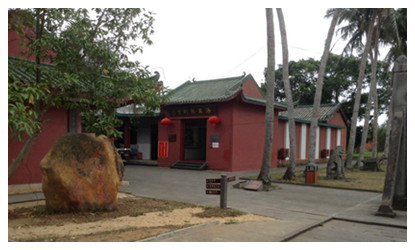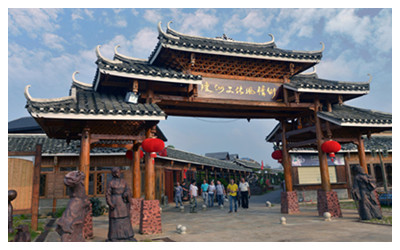Skype: neodalle-travel
Tel: +86 135 7447 2266
E-mail: sales@visitaroundchina.com
 In ancient China, Hainan Island was a savage land, and few people lived there. The government officials who did something wrong or displeased the emperor would be relegated to this island. It should be a thing of sadness to be relegated to this savage island, but when the unlucky officials went there, they came to realize that it was actually a blessing to settle there. For example, the most famous poet in the Song Dynasty (960-1279), Su Dongpo, was once relegated there, and this enchanting island really cast a spell over him. He left a lot of poems there, which highly praise the beauty of Hainan Island. He believed that it would be a happy thing to rest there after death, because the scenery there was the best he had ever seen.
In ancient China, Hainan Island was a savage land, and few people lived there. The government officials who did something wrong or displeased the emperor would be relegated to this island. It should be a thing of sadness to be relegated to this savage island, but when the unlucky officials went there, they came to realize that it was actually a blessing to settle there. For example, the most famous poet in the Song Dynasty (960-1279), Su Dongpo, was once relegated there, and this enchanting island really cast a spell over him. He left a lot of poems there, which highly praise the beauty of Hainan Island. He believed that it would be a happy thing to rest there after death, because the scenery there was the best he had ever seen.
History of Hainan
Known in ancient times as Zhuya, Qiongzhou or Qiongya, Hainan has a long history. It can be inferred from the 200 Neolithic sites discovered by archaeologists and the existing historical documents that Hainan Island came into existence with human activities at least 6,000 years ago. According to Records in Qiongzhou Prefecture, Hainan was remotely controlled by the government in Qin dynasty since there was no any official administrative establishment there at that time. It was not until the first year of Western Han dynasty (110 BC) that the Dan’er Commandery and Zhuya Commandery were set up. Three years after Emperor Yuan succeeded to the throne (46 BC), the two Commanderies were cancelled and replaced by a County called Zhulu. In Southern and Northern dynasties ruled by Emperor Wu of Liang, Ya District (Yazhou) was founded. In Sui dynasty, Linzhen and Zhuya Commanderies were established, while in Tang dynasty, Hainan was divided into five districts (Zhou): Ya District, Qiong District, Zhen District, Dan District and Wan District. In Song dynasty, the central government set up one District and three Juns (a Administrative unit in Song dynasty) in Hainan, with Qiong District administering five counties, Nanning Jun administering three counties, Wan’an Jun two counties, and Jiyang Jun three counties. In Yuan dynasty, the administrative structure in Hainan remained unchanged, following what it was in Song dynasty. In Ming dynasty, Qiongzhou Prefecture was established in Hainan, administering Dan District, Wan District and Ya District, and 10 counties. In Qing dynasty, the administrative establishment in Hainan remained the same as that in Ming dynasty. At the early stage of the establishment of the Republic of China, the previous administrative system was deserted and an Administrative Region Office was established in Hainan, and then Hainan was changed into Administrative Supervision Region and later Special Administrative Region. After the liberation of the island in 1950, Hainan was run under Administrative Region Office. In 1988, Hainan was approved by the central government to be established as a province. It took 2,098 years for Hainan’s administrative establishment to evolve from District or County in Han dynasty to a Province in 1988.
Ethnic Minority Culture of Hainan
Hainan Province has a population of over 7 million, among which Han nationality is the overwhelming majority, while the rest are from 37 ethnic minorities. The Li and Miao ethnic groups comprise a large proportion of the minority population. The rich traditional cultures of the ethnic minorities have been well preserved there, which diversify the culture of Hainan Province. As well as the Han people, there are a number of minority groups living in the province. The Li Ethnic Minority Group is the native group of Hainan. With a population of over 1.3 million, they inhabit the Mt. Wuzhishan and southwestern areas of the Island. The Li Minority has a close cultural relationship with Zhuang and Buyi minorities. Their most famous product, Li Brocade, has been greatly admired since the Tang Dynasty (618-907).
Famous Festivals in Hainan
This island is also called 'Coconut Island' for its production of coconuts. Each year in late March or early April, the islanders hold a 'Coconut Festival'. During the festival, visitors can go to Haikou to appreciate the coconut lanterns, travel to Wenchang to taste the delicious coconuts, head for Sanya to watch the dragon boat race and a folk martial art competition, approach Tongshi to attend the Sanyuesan carnival. Sanyuesan is a traditional festival celebrated on every March, 3rd of Chinese lunar calendar by the local Li people. On that day, the Li worship their ancestors and pray for a good harvest. It is also a 'love festival' for the young people to seek love. Visitors may also watch the traditional Li wedding ceremonies on that day.
 Haikou Qiongzhou Culture and Customs Street
Haikou Qiongzhou Culture and Customs Street
Haikou Qiongzhou Culture and Customs Street stretches for 500 meters on the banks of the beautiful Nandu River, with 30 simple exhibition halls displaying exhibits on Hainan culture, ecology, attractions, and cuisine, as well as Haikou’s intangible cultural heritage. Here you can buy Hainan souvenirs, including Hainan rosewood, pottery, sapphires, and jade, and enjoy food from Hainan, Japan, Korea, and Taiwan.
Famous Universities in Hainan
Hainan University: It is the largest and key university of Hainan Province. It has Foreign Language schools teaching English, Japanese and French.
Location: No. 58, Renmin Avenue, Haikou, Hainan
Hainan Normal University: Established in 1949, it is the oldest advanced institute of Hainan Province. And it is the key normal university in Hainan. Chinese Center for Foreigners of the university is approved by the State Council to enroll foreign students from Japan, Thailand, USA, Korea and Germany, etc.
Location: No. 99, Longkun South Road, Haikou, Hainan
Hainan Dialects
Hainan natives speak quite a number of dialects, and about 10 local dialects are spoken in this province, including Hainan dialect, Li dialect, Lin’gao dialect, Danzhou dialect, Jun dialect, and Miao dialect. Hainan dialect is spoken extensively by 5 million people across the island. Hainan dialect speakers are mainly distributed in Haikou, Qiongshan, Wenchang, Qionghai, Wanning, Ding’an, Tunchang and Chengmai and the coastal areas in Lingshui, Ledong, Dongfang, Changjiang and Sanya. The pronunciations and intonations of Hainan dialect are slightly different in different areas of the island, and the accent in Wenchang is generally considered the standard for Hainan dialect. The culture in Hainan is uniquely charming. Hainan’s culture is unique in that it has assimilated fine elements from different categories of unique cultures, including central plain culture, local folk culture, culture derived from the historical practice of sending disgraced officials in exile to Hainan, immigration culture, border culture and ecological culture in this tropical island, to name just a few. Among all cultures mentioned above, the central plain culture, which has taken root in Hainan since Qin dynasty, is now the mainstream of Hainan’s culture integrated with the local folk culture.
 Ask Questions ?
Ask Questions ?